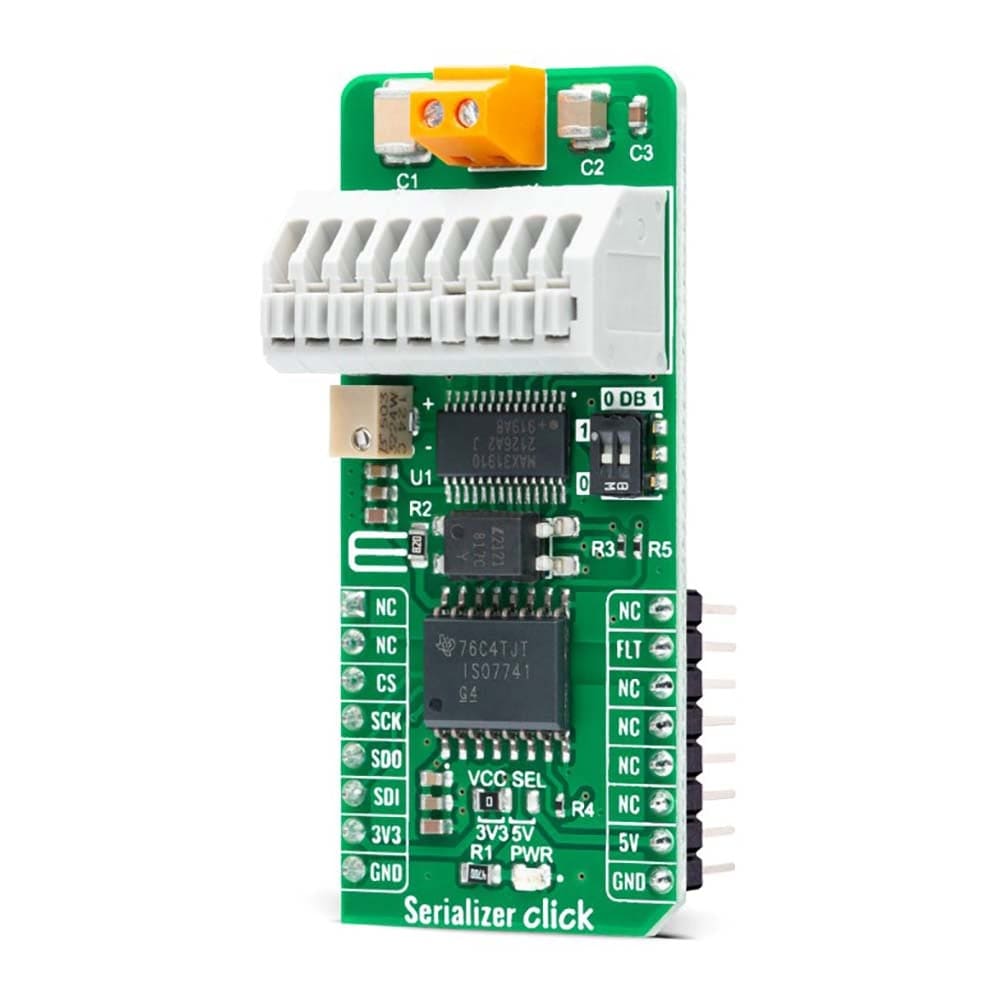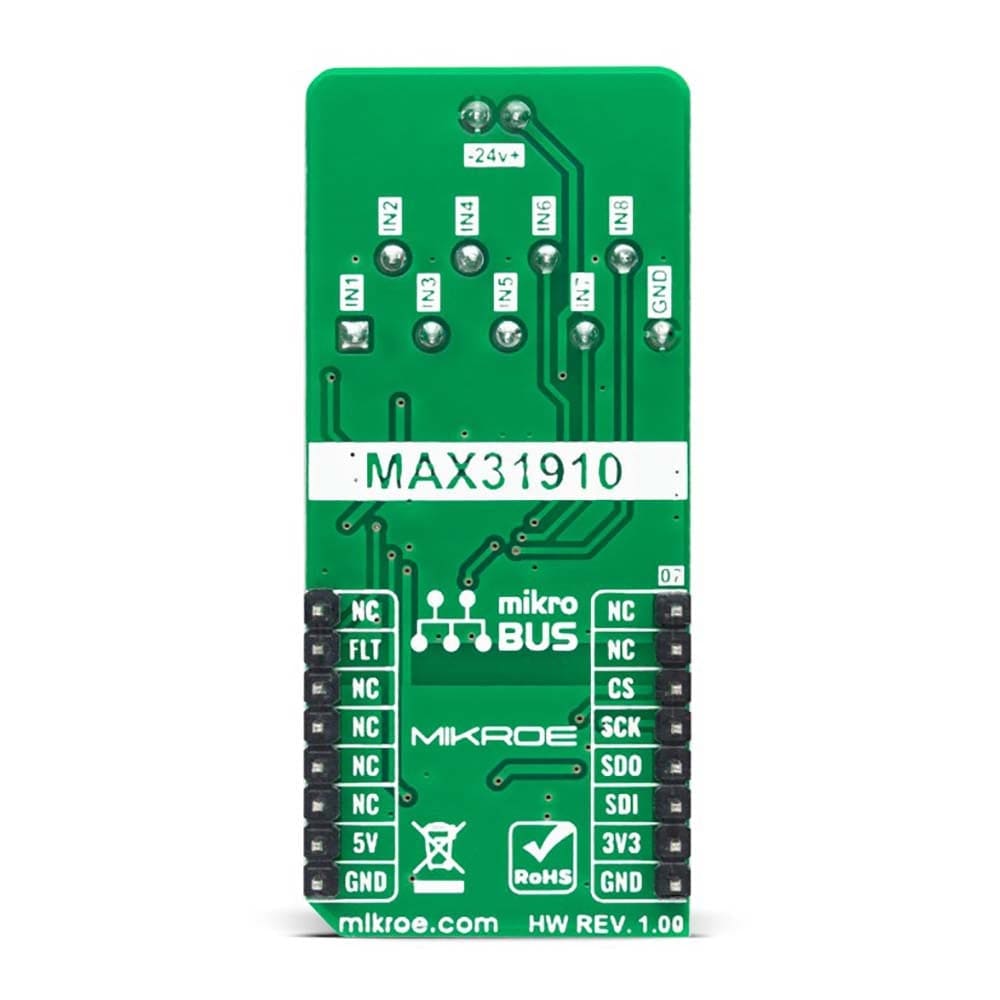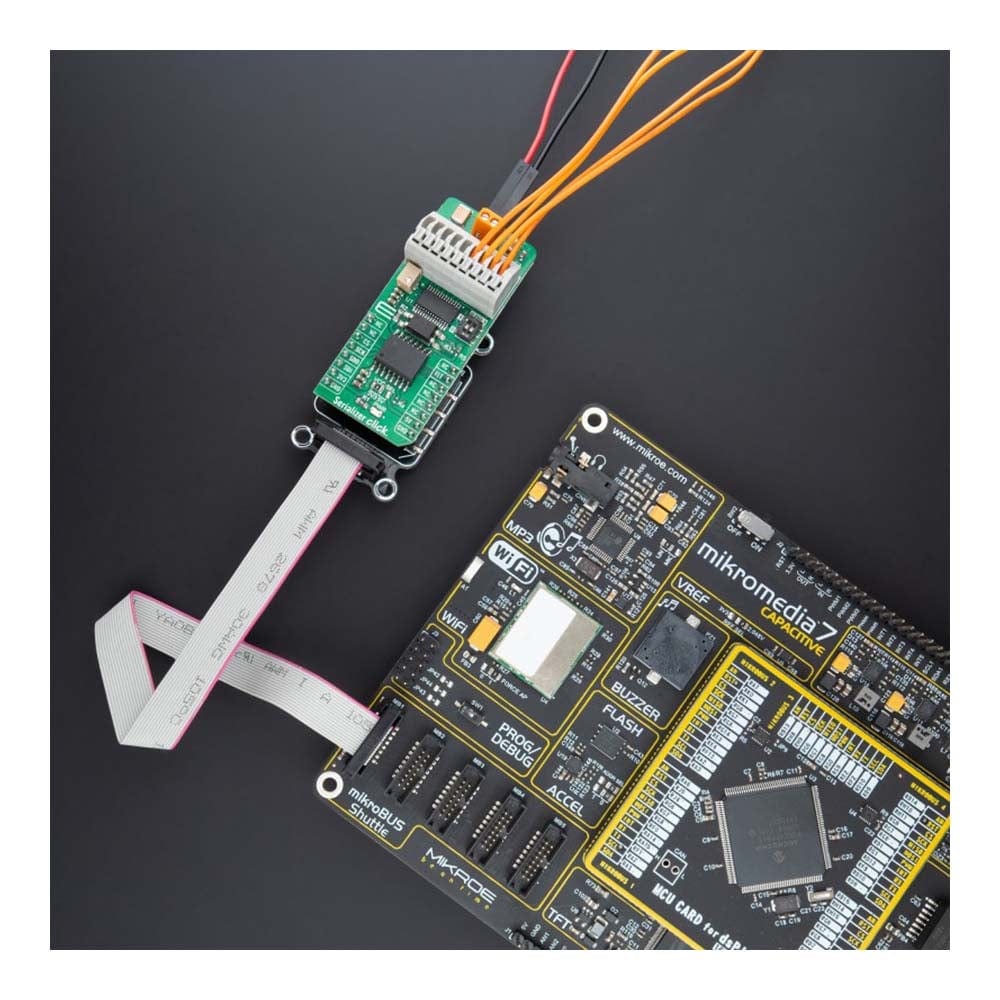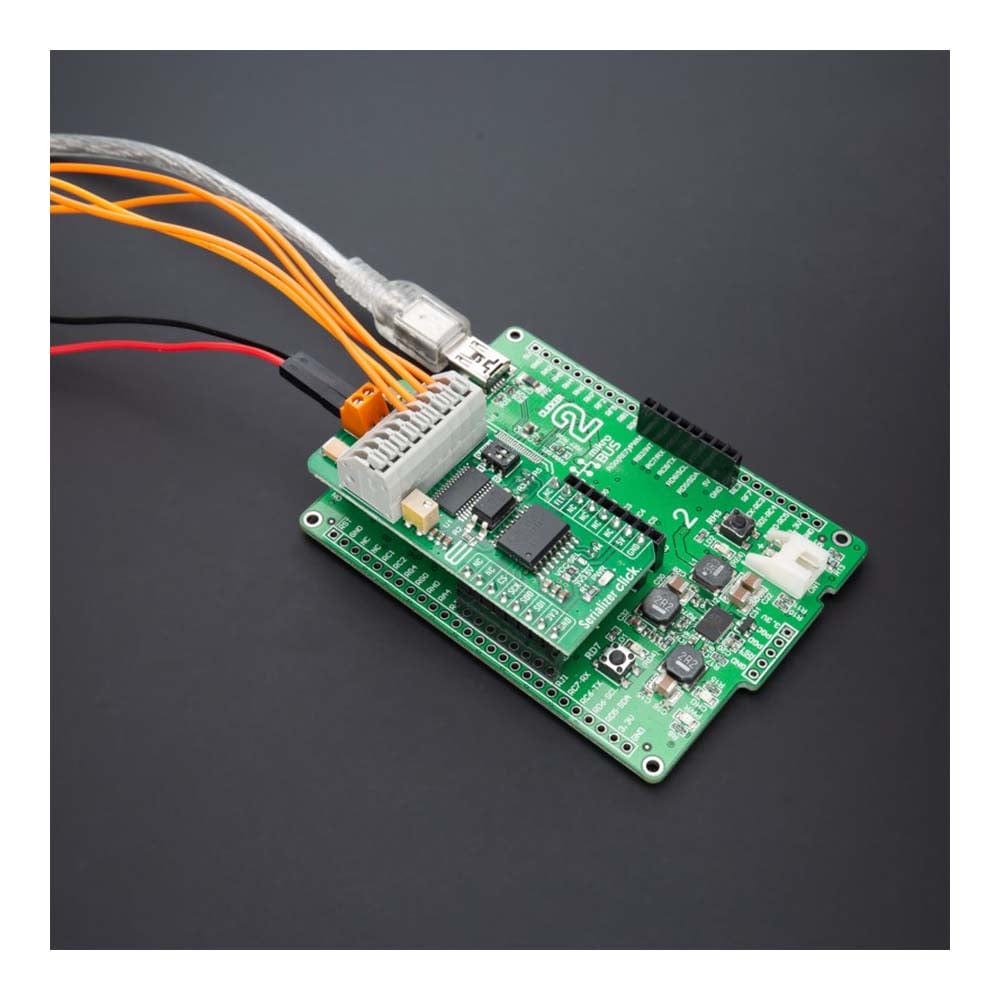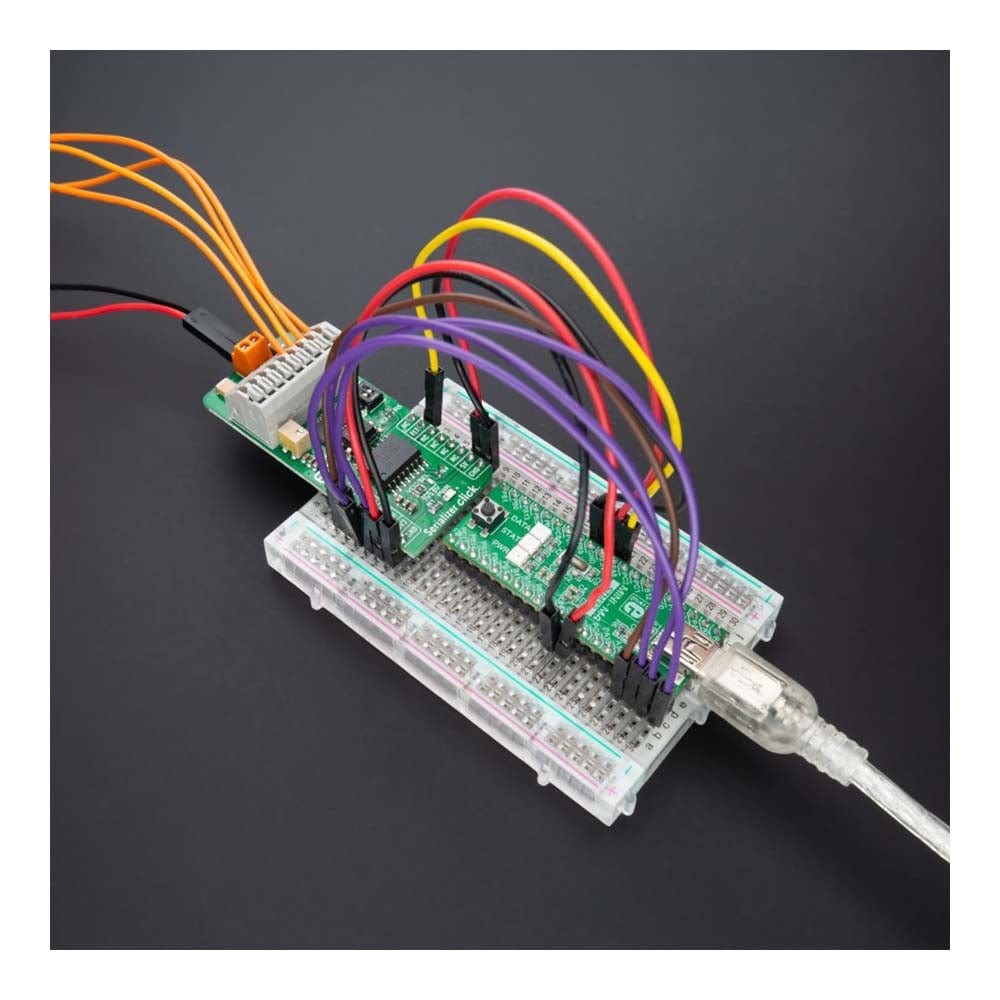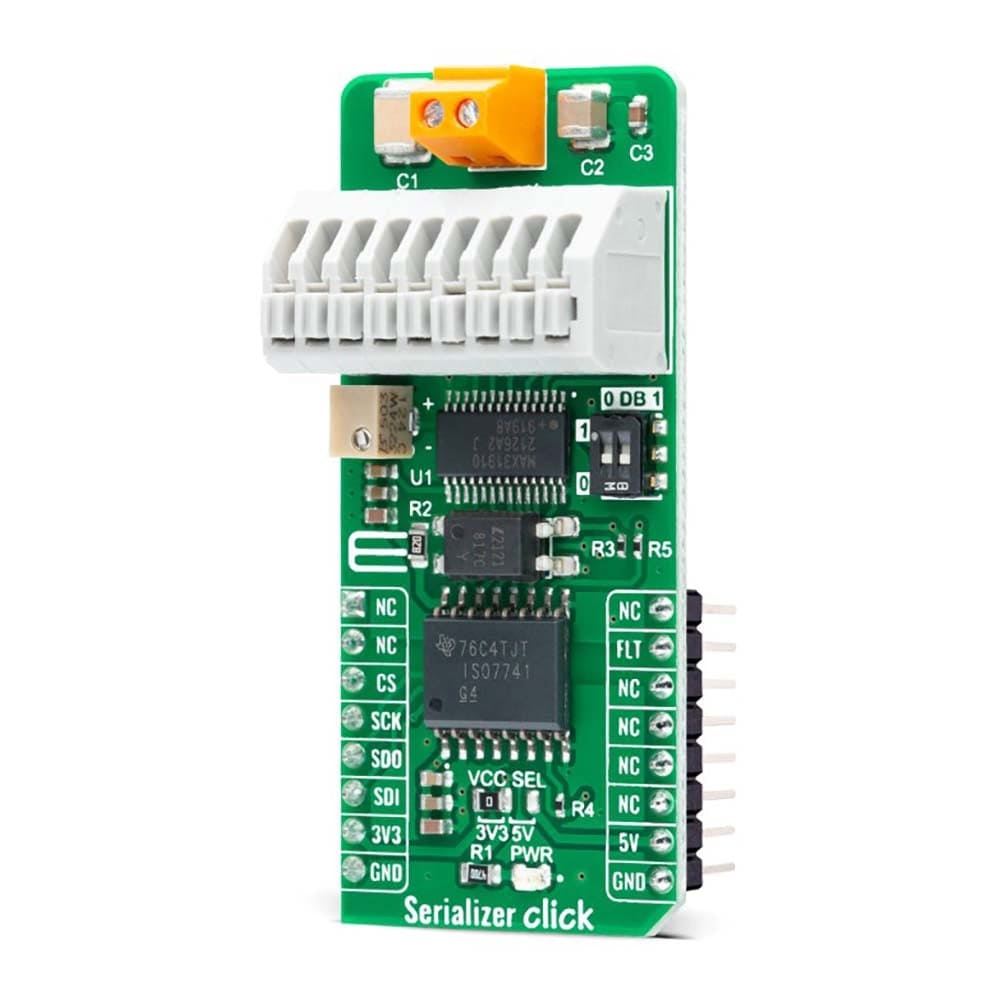
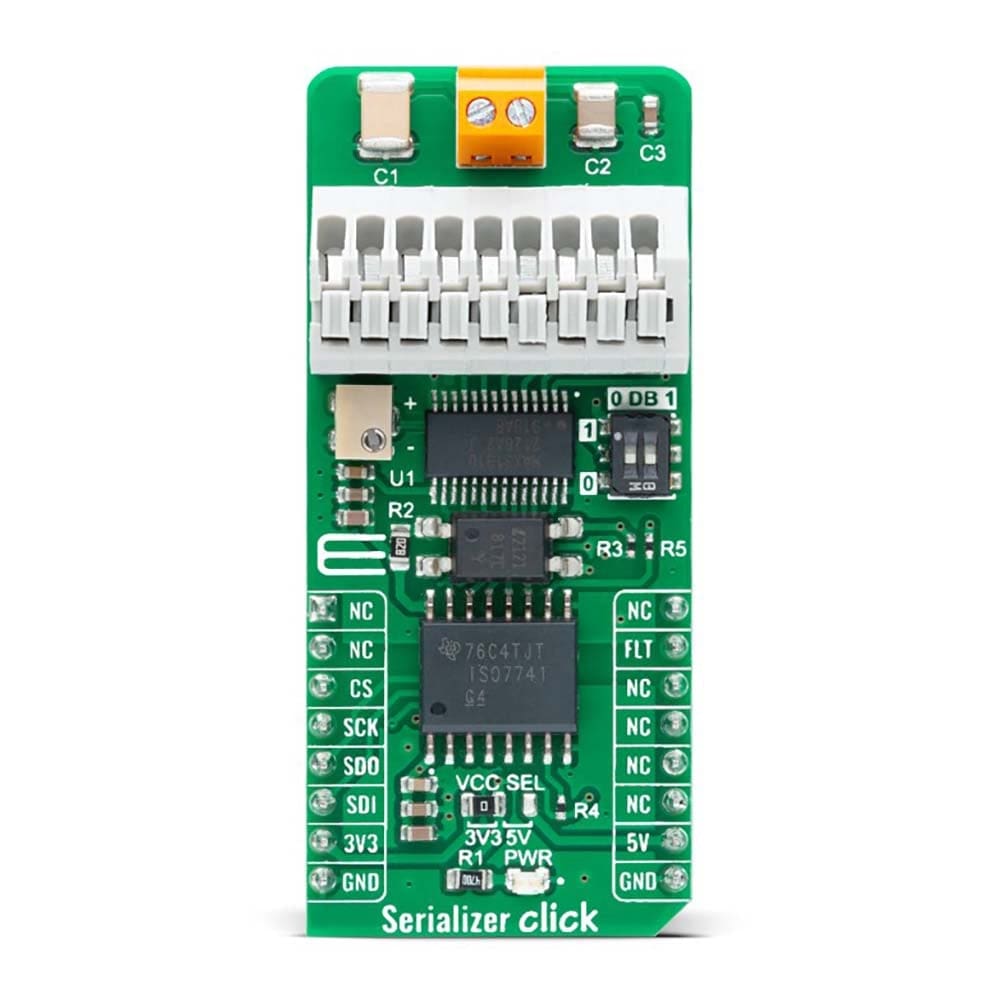
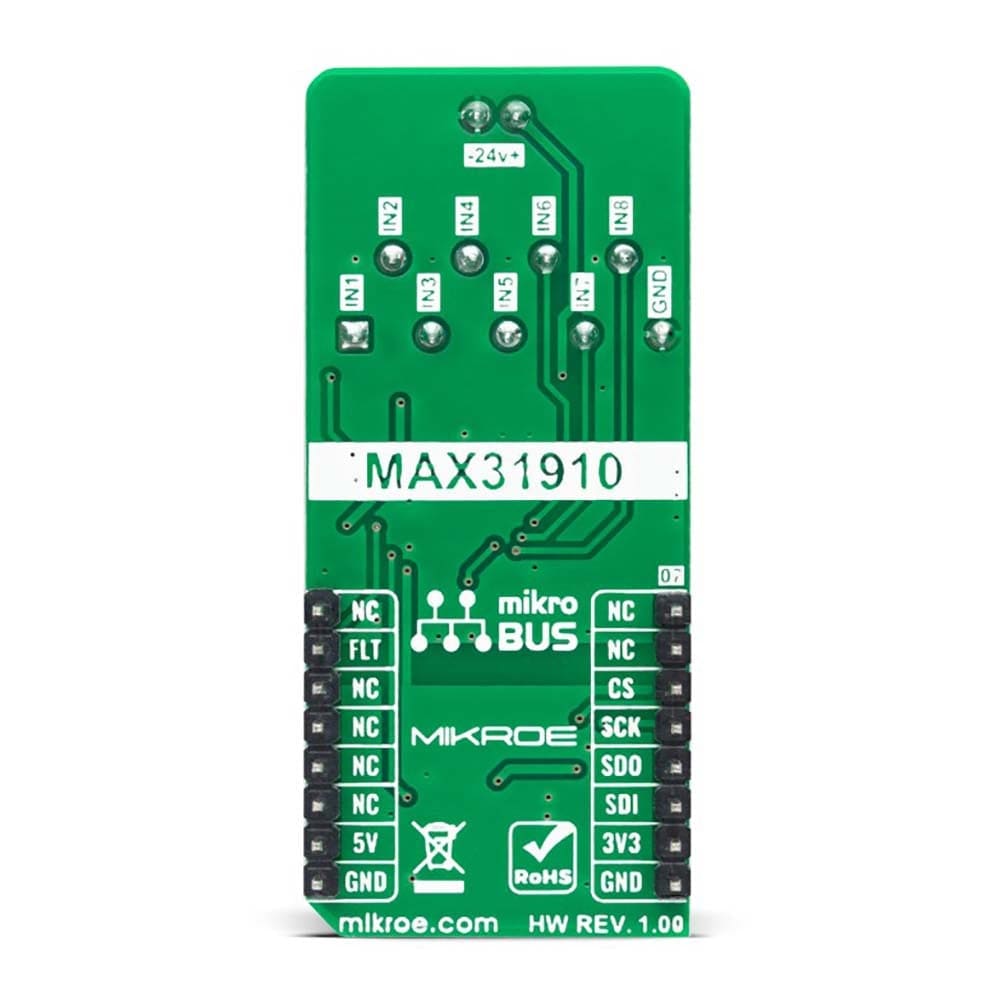
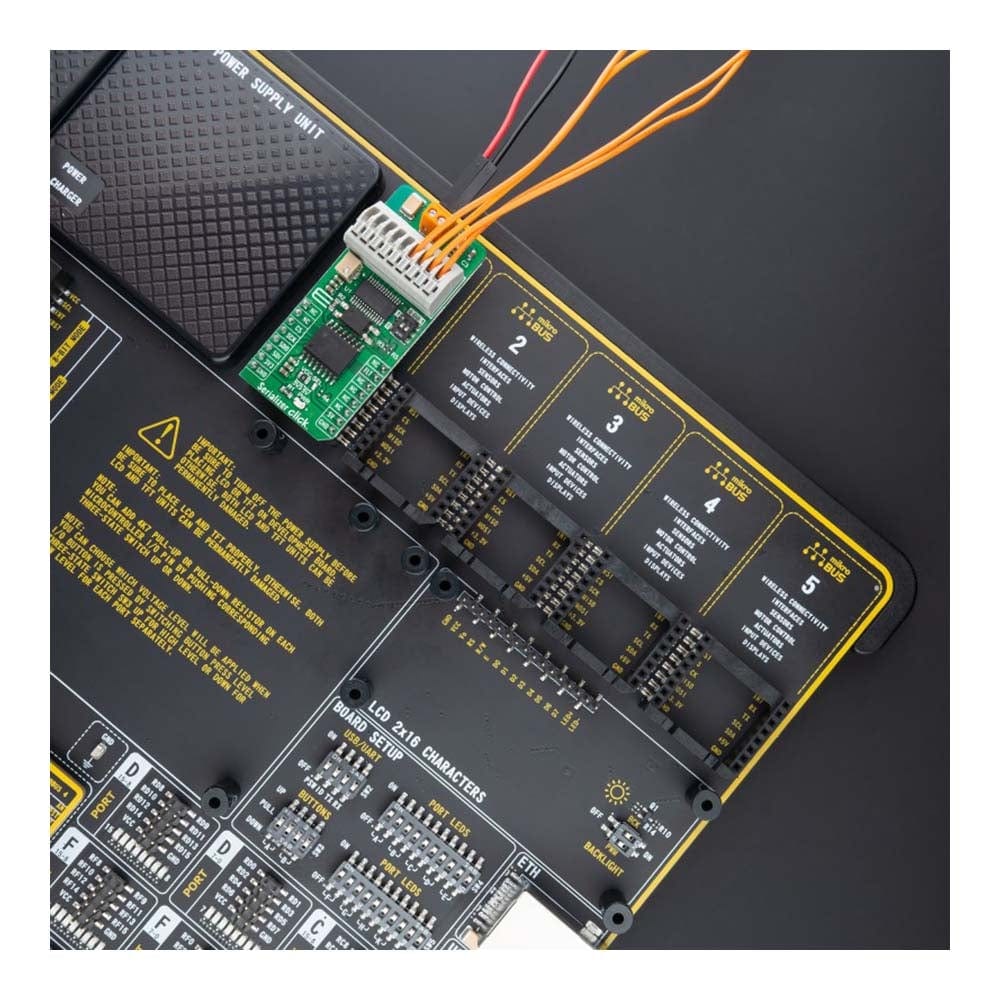
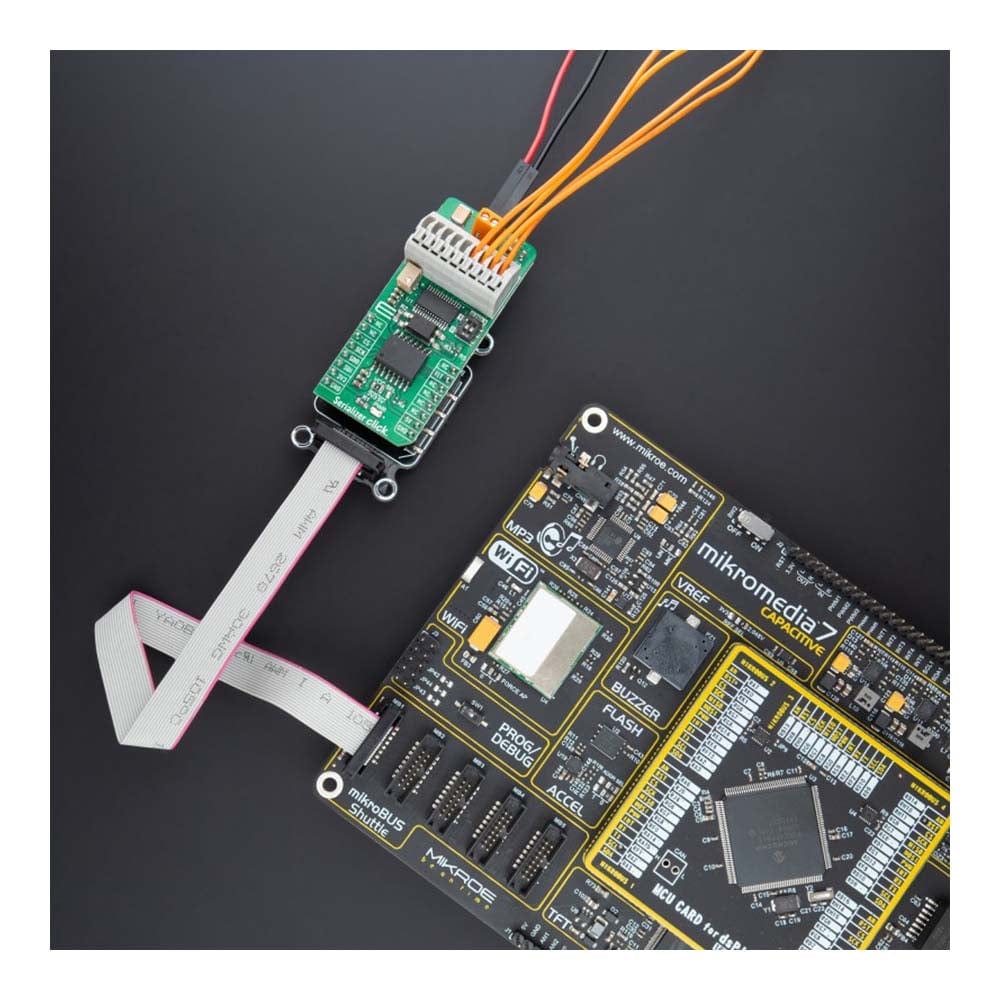
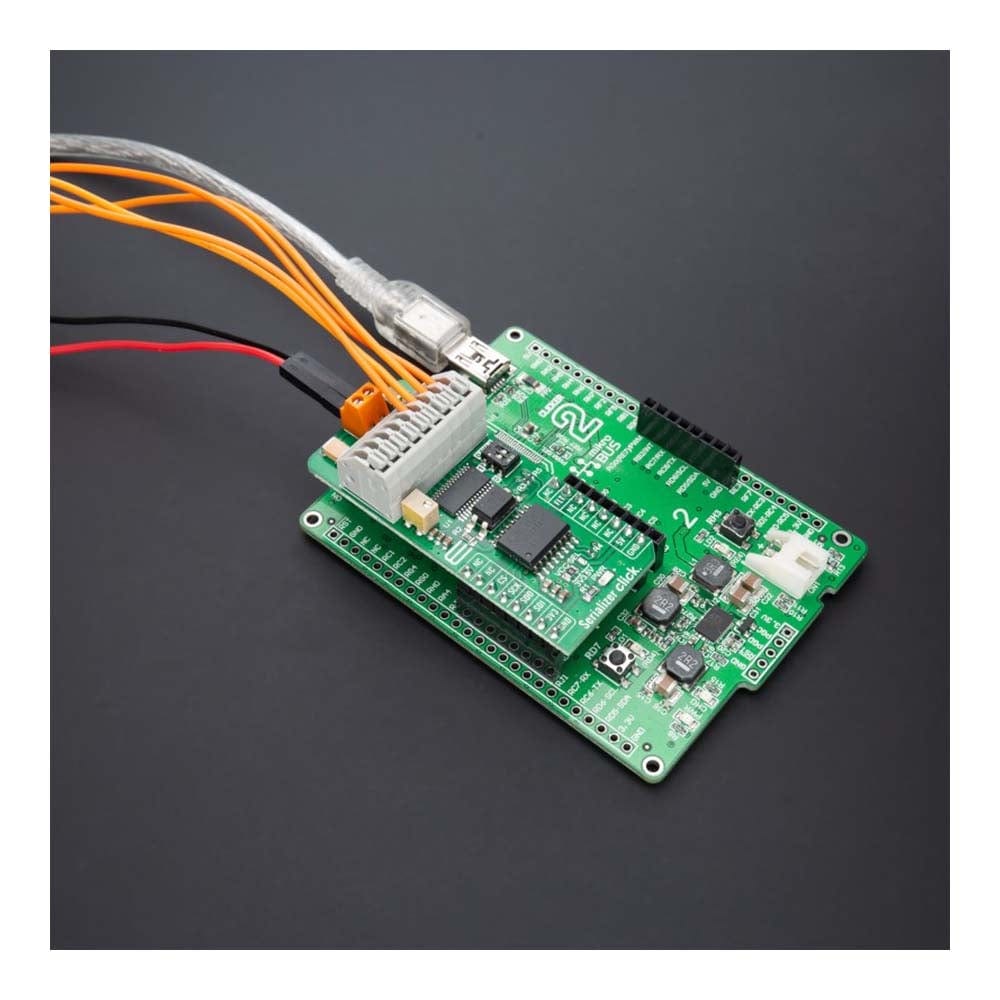
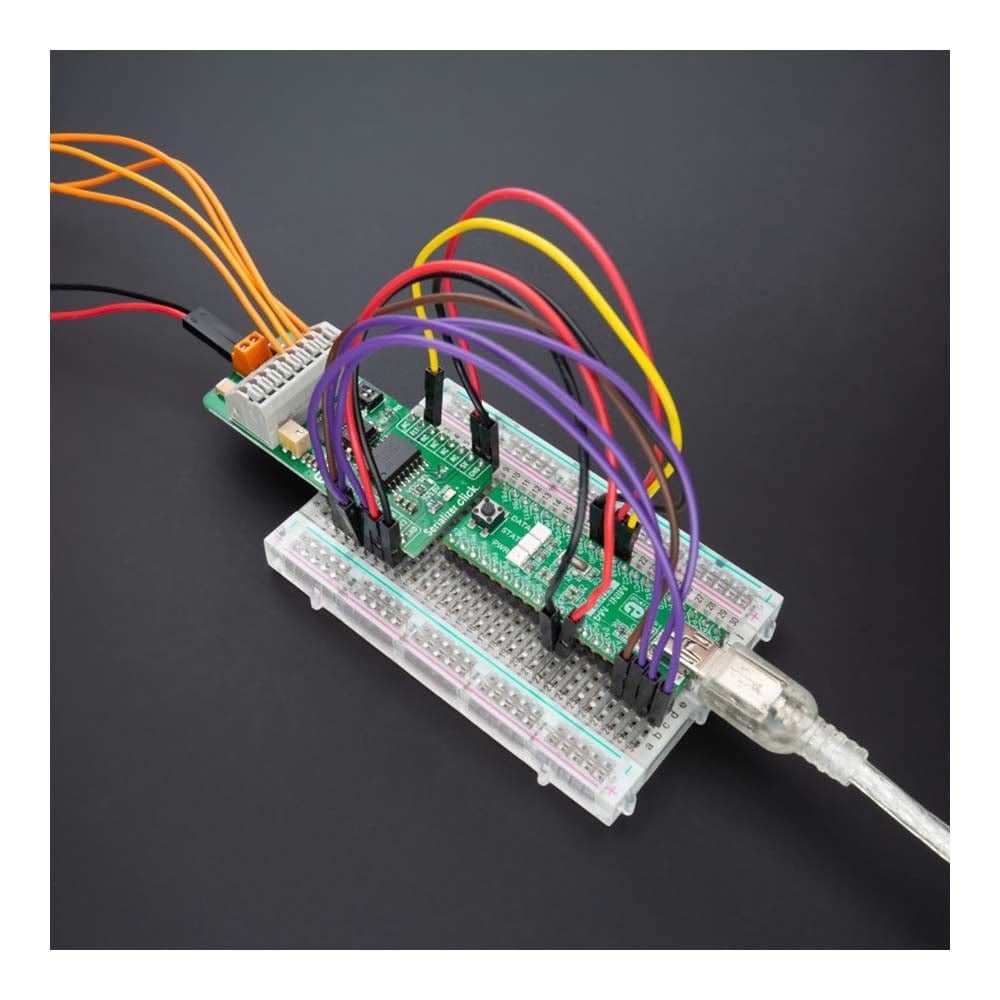
Overview
The Serializer Click Board™ is a compact add-on board that contains a digital input translator/serializer. This board features the MAX31910, an eight-channel digital input serializer for high-channel density digital input modules in industrial and process automation from Maxim. The MAX31910 translates, conditions, and serializes the 24V digital output of sensors and switches to 5V CMOS-compatible signals required by the MCU. It provides the front-end interface circuit of a programmable logic controller (PLC) digital input module. It communicates with MCU via the SPI interface and comes in configuration with an installed digital isolator.
The Serializer Click Board™ is suited for various applications such as industrial, process, and building automation, digital input modules for PLCs, and more.
Downloads
How Does The Serializer Click Board™ Work?
The Serializer Click Board™ uses the MAX31910, an eight-channel digital input translator/serializer for high-channel density digital input modules in industrial and process automation from Maxim Integrated, now part of Analog Devices. It features integrated current limiting, low-pass filtering, and channel serialization. Input current limiting allows a significant reduction in power consumed from the field voltage supply (external typical 24V) compared to traditional discrete resistor-divider implementations. The device uses patent-pending circuit techniques to further reduce power beyond possible input current limiting alone.
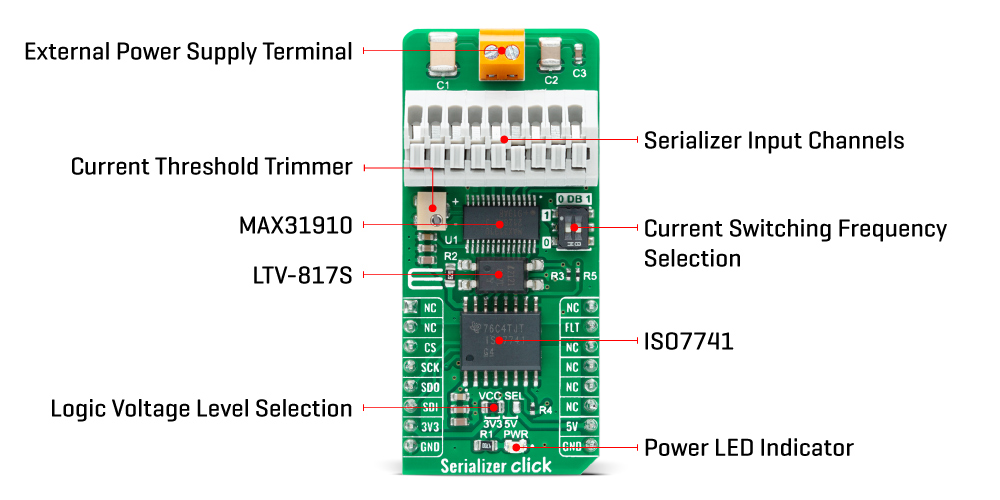
The MAX31910 translates, conditions, and serializes the 24V digital output of sensors and switches to 5V CMOS-compatible signals required by the MCU. It provides the front-end interface circuit of a programmable logic controller (PLC) digital input module. Selectable on-chip low-pass filters allow flexible debouncing and filtering sensor outputs based on the application. The serializer is stackable so that any number of input channels (IN1-IN8) can be serialized and output through only one SPI-compatible port.
The serializer inputs (IN1-IN8) sense the state (ON vs. OFF) of field sensors by monitoring both voltage and a current flowing through the sensor output. The current sinking through these input pins rises linearly with input voltage until the limit set by the current clamp is reached (set by an onboard potentiometer). Any voltage increase beyond this point does not further increase the input current.
The Serializer Click Board™ communicates with MCU through a standard SPI interface in a configuration with installed digital isolators (ISO7741 and LTV-817S). Also, it uses an interrupt pin, the FLT pin of the mikroBUS™ socket, used as a 'fault' indicator which immediately notifies the host when a fault such as an overtemperature or undervoltage condition occurs. It also has a two-channel switch labelled DB, which determines the current switching frequency. The current switching clock period is automatically selected according to a switch position.
The Serializer Click Board™ can operate with both 3.3V and 5V logic voltage levels selected via the VCC SEL jumper. This way, it is allowed for both 3.3V and 5V capable MCUs to use the communication lines properly. However, the Click board™ comes equipped with a library containing easy-to-use functions and an example code that can be used, as a reference, for further development.
SPECIFICATIONS
| Type | Measurements |
| Applications | The Serializer Click Board™ be used for various applications such as industrial, process, and building automation, digital input modules for PLCs, and more |
| On-board modules | MAX31910 - eight-channel digital input translator/serializer from Maxim Integrated, now part of Analog Devices |
| Key Features | Low power consumption, highly integrated, eight channels, robust features and performance for industrial environments, flexible power supply capability, and more |
| Interface | SPI |
| Compatibility | mikroBUS |
| Click board size | L (57.15 x 25.4 mm) |
| Input Voltage | 3.3V or 5V,External |
PINOUT DIAGRAM
This table shows how the pinout of the Serializer Click Board™ corresponds to the pinout on the mikroBUS™ socket (the latter shown in the two middle columns).
| Notes | Pin |  |
Pin | Notes | |||
|---|---|---|---|---|---|---|---|
| NC | 1 | AN | PWM | 16 | NC | ||
| NC | 2 | RST | INT | 15 | FLT | Fault Indicator | |
| SPI Chip Select | CS | 3 | CS | RX | 14 | NC | |
| SPI Clock | SCK | 4 | SCK | TX | 13 | NC | |
| SPI Data OUT | SDO | 5 | MISO | SCL | 12 | NC | |
| SPI Data IN | SDI | 6 | MOSI | SDA | 11 | NC | |
| Power Supply | 3.3V | 7 | 3.3V | 5V | 10 | 5V | Power Supply |
| Ground | GND | 8 | GND | GND | 9 | GND | Ground |
ONBOARD SETTINGS AND INDICATORS
| Label | Name | Default | Description |
|---|---|---|---|
| LD1 | PWR | - | Power LED Indicator |
| JP1 | VCC SEL | Left | Logic Level Voltage Selection 3V3/5V: Left position 3V3, Right position 5V |
| SW1 | DB | - | Current Switching Frequency Selection 1/0: Upper position 1, Lower position 0 |
| P1 | - | - | Current Threshold Trimmer |
SERIALIZER CLICK ELECTRICAL SPECIFICATIONS
| Description | Min | Typ | Max | Unit |
|---|---|---|---|---|
| Supply Voltage VCC | 3.3 | - | 5 | V |
| External Supply Voltage | 7 | 24 | 36 | V |
| Input Data Rate | - | 200 | - | kHz |
| Operating Temperature Range | -40 | +25 | 125 | °C |
| General Information | |
|---|---|
Part Number (SKU) |
MIKROE-4925
|
Manufacturer |
|
| Physical and Mechanical | |
Weight |
0.02 kg
|
| Other | |
Country of Origin |
|
HS Code Customs Tariff code
|
|
EAN |
8606027389788
|
Warranty |
|
Frequently Asked Questions
Have a Question?
Be the first to ask a question about this.

